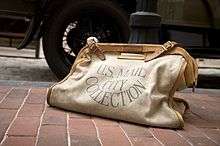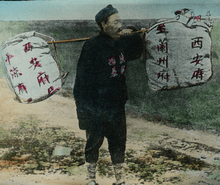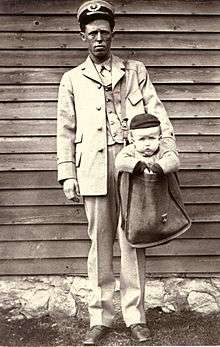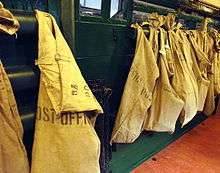Mail bag


A mail bag or mailbag is a generic term for a type of bag used for collecting, carrying, categorizing, and classifying different types of postal material, depending on its priority, destination, and method of transport. It is oftentimes used by a post office system in transporting these different grades of mail.[upper-alpha 1] The mailbag is carried by some means of transporting like a mail carrier, animal (e.g., mule, horse), or a mobile post office. Letters and printed material delivered by mail in the seventeen-hundreds were carried by horse in a saddle bag. There are several different types of mailbags for different purposes (e.g., transporting mail to and from post offices, delivering mail to businesses and homes. These different styles of mailbags depend on its size and purpose. It can range from "a large bag used for transporting mail on a truck, plane, etc." to a simple "postbag" used by a mail carrier to deliver mail.[1]
The idea of having mail bags on board ships traveling between Jamaica and Great Britain was established as early as 1780. The name of the ship carrying a letter was put on the corner of the letter so that it would be put into the proper mail bag for the destination intended.[2]
A mailbag throughout the United States history has been called various names depending on its form and function at the time, some of which are now obsolete. Among these names are mail sack, mail satchel, mail pouch, catcher pouch, mochila, and portmanteau.[3][4][5]
Private Mail Bags or so-called "Locked Bags" are a worldwide solution for specialized mail delivery to a single location. Like PO Box addresses, Private Mail Bag addresses omit the name of the building and street, and include only the number allocated to the user.[6] Private Mail Bag addresses are often used in countries in Africa where there may be no street delivery service. In Europe and North America, where street delivery is more commonplace, large users may be allocated their own postal codes, and consequently need only use their physical address in correspondence; the postal code implies that the recipient receives mail by caller service.[6] Private mail bags may be in lieu of a Post Office Box,[6] but sometimes can go so far as to have an individualized corporate zip code.[upper-alpha 2]
Types
The U.S. National Postal Museum says that any bag that carries mail (e.g., letters, magazines, advertisement brochures, packages) is defined as a "Mailbag".[3] A mailbag is called a postbag in England.[7][8] The form and structure of mailbags has implications for fatigue and industrial injuries to mail carriers.[9]
Mail sacks
A mail sack is a lower security class mailbag used to carry second-class, third-class, and fourth-class mail. It does not have a locking mechanism with it.[3]
Mail satchel
A mail satchel is a device letter carriers use over-the-shoulder for assisting the delivery of personal mail to businesses and homes.[3]
Mail pouch
A mail pouch is a strong material (e.g., canvas) mail bag designed to lock at the top to prevent access into the bag. They are usually used for transporting First-class and registered mail to and from different post offices. Mail pouches also carry military domestic and military airmail.[3]
Catcher pouch
A catcher pouch was a mail bag used only by the Railway Post Office in exchanging mail when the train did not stop at the town.[10] It was most popular in the late nineteenth century and the early twentieth century.[11]
Mochila
A mochila was a removable lightweight leather cover put over a horse saddle for carrying mail and was used by the Pony Express.[4]
Portmanteau
A portmanteau was a traveling suitcase used as a mailbag in the eighteenth and nineteenth centuries to carry both letters and newspapers. When it opened it had two different compartments, one for letters and the other for newspapers.[12]
Mailbag in popular culture

- With the advent of Parcel Post in 1913, after some adults sent their children in the mails— with postage affixed to clothing— the U.S. Postmaster General issued regulations barring such shipment. The theory was that children were under the 50 lb. weight limit, and that it was a lot cheaper to mail them than to pay rail fares. In part, the regulation followed a letter inquiring as to whether parcel post would be appropriate, and the Postmaster General was of the opinion that children were not within the definition of "bees and bugs" which were the only fauna permitted to be mailed.[13] Nevertheless, several children were actually mailed. On 13 June 1920, sending children by Parcel Post was officially forbidden.[13][14] Thereafter, a mail bag stuffed with a child was prominently featured in a humorous photograph to illustrate the prohibition.[15]
- The form of this sack is so evocative and iconic that it inspired the "counterfeit mail bag" in The J. Peterman Company catalog.[16]
- Phantom Ranch, in the Grand Canyon, is one of two places in America where mail is still transported by mule in specially designed leather mailbags.[17] The other place is Supai, Arizona, inhabited by Havasupai native American Indians, also in the Grand Canyon.[18][19]
- Illusionist and Escapologist Houdini first popularized the so-called "Mailbag escape" using U.S. Postal Service mailbags, after having found the British postbags unsuitable.[20]
See also
Footnotes
- ↑ However, according to the Oxford English Dictionary, a second definition is "the letters received by a person, especially a public figure." Thus, for example, the "Mailbag special" featuring letter requests from viewers is a recurrent event on MythBusters.
- ↑ For example, the Washington Post has the unique ZIP code 20071.
References
- ↑ "Definition of mailbag noun". Cambridge Business English Dictionary. Cambridge University Press. Retrieved September 2, 2012.
- ↑ Morton, C.S.; A postal employee. "Jamaica: Its Postal History, Postal Stamps and Postmarks: The Jamaica Post Office (1671-1926)" (PDF). p. 1. Retrieved September 5, 2012.
|chapter=ignored (help) - 1 2 3 4 5 Marsh, Allison (March 2006). "Prototype Mail Pouch". Former Object of the Month. National Postal Museum, Smithsonian Institution. Retrieved August 15, 2012.
- 1 2 Pope, Nancy (December 2007). "Mochila". Former Object of the Month. National Postal Museum, Smithsonian Institution. Retrieved August 17, 2012.<
- ↑ Arago Researcher Program Style Guide for Researchers and Editors
- 1 2 3 "Locked bags". Australia Post. Retrieved October 13, 2012.
- ↑ "Postbag". TheFreeDictionary.com. Retrieved August 17, 2012.
- ↑ "Postbag". Merriam Webster Dictionary. Retrieved August 17, 2012.
- ↑ Bloswick, D. S.; Gerber, A.; Sebesta, D.; Johnson, S.; Mecham, W. (June 1994). "Effect of mailbag design on musculoskeletal fatigue and metabolic load". Human Factors. 36 (2, number 2): 210–8. PMID 8070787.
- ↑ Cushing, Marshall Henry (1892). Story of our post office: the greatest government department in all its phases (Google eBook). Boston, Massachusetts: A.M. Thayer. p. 116. Retrieved August 15, 2012.
- ↑ Pope, Nancy (December 2007). "Railway Mail Crane". Former Object of the Month. National Postal Museum, Smithsonian Institution. Retrieved August 16, 2012.
- ↑ Marsh, Allison (May 2, 2006). "Moving & Sorting Equipment: Mailbag associated with Postmaster general Return J. Meigs, Jr.". National Postal Museum, Smithsonian Institution. Retrieved August 16, 2012.
- 1 2 "WANTS BABY SENT BY MAIL.; Pathetic Inquiry as to Parcel Post Worries Postmaster General". New York Times. Washington D.C. January 16, 1913. Retrieved October 5, 2012.
- ↑ "Precious Packages—America's Parcel Post Service". Smithsonian Institution, National Postal Museum. Retrieved October 6, 2012.
- ↑ Rosenberg, Jennifer (June 26, 2008). "Sending Children by Parcel Post". About.com Guide. Retrieved October 5, 2012.
- ↑ "Counterfeit Mailbag". The J. Peterman Company. Retrieved August 17, 2012.
- ↑ Phantom Ranch Canteen Menu Board - Grand Canyon
- ↑ Geist, Bill (January 23, 2000). "Special Delivery: Mail By Mule". CBS News Sunday Morning. CBS News. Retrieved 2009-09-30.
- ↑ "Grand Canyon Phantom Ranch" (pdf). Canyon Tough Adventures. October 11, 2011. Retrieved August 21, 2012.
- ↑ Cannell, J. C. (1973). The Secrets of Houdini. New York: Dover Publications. pp. 36–41. ISBN 0486229130. Retrieved August 17, 2012. ISBN 9780486229133
Further reading
- Cushing, Marshall (1893). The Story of Our Post Office: The Greatest Government Department in all its Phases. Boston, Massachusetts: A.M. Thayer & Co. at Internet archive
- Melius, Louis (1917). The American postal service: history of the postal service from the earliest times. The American system described with full details of operation. Washington, D.C.: National Capital Press. Retrieved August 15, 2012. at Internet Archive
External links
| Look up mailbag in Wiktionary, the free dictionary. |
| Wikimedia Commons has media related to mail bags. |

